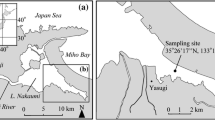Abstract
The diurnal exchange of oxygen, over the sediment-water interface, was measured on ‘undisturbed’ sediment cores incubated on the river bank of three reaches in the river Susaa, Denmark. The incubation chambers were equipped with a double pumping system, driving an internal and an external flow, respectively. The internal flow created a unidirectional flow over the sediment surface, with the same velocity as the natural river flow. River water was continuously pumped through the incubation chambers (external flow). Magnetic valves alternately shifted the inlet and outlet water through a registration chamber equipped with an oxygen probe and a temperature transducer (A/D 540, integrated circuit). The potential was amplified and registered every minute on a tape recorder.
The rate of exchange of oxygen in the chambers was described by the following equation:
Various methods for the numerical solution of the differential equation were used. Due to a small amount of ‘noise’ on the probes, the cubic spline method gave an unrealistically high variation in the oxygen uptake. A better description was obtained, when a Fourier transformation of the inlet and outlet concentrations of oxygen was made. When 15 Fourier coefficients were used, the r-value of the model was better than 0.996.
On permanently dark sediment samples, a hysteresis effect between the oxygen exchange rate and the oxygen concentration and temperature appeared. The exchange rates were lower in periods with increasing oxygen concentration. A minimum in the exchange rate was obtained, before the minimum in the concentration of oxygen and temperature was found. This type of hysteresis could be explained by equilibration in connection with the transient state conditions. The hysteresis was probably enlarged by shifts in the size of the aerobic layer in the sediment. The importance of the hysteresis in oxygen balance models for rivers is discussed.
Similar content being viewed by others
References
Belanger, T. V., 1981. Benthic oxygen demand in lake Apopka, Florida. Wat. Res. 15: 267–274.
Bott, T. L. & Brock, J. T., 1978. A comparison of methods for measuring primary productivity and community respiration in streams. Hydrobiologia 60: 3–12.
Bowman, G. J. & Delfino, J. J., 1980. Sediment oxygen demand techniques: a review and comparison of laboratory and in situ systems. Wat. Res. 14: 491–499.
Edwards, R. W. & Rolley, H. L. J., 1965. Oxygen-consumptions of river muds. J. Ecol. 53: 1–19.
Fillos, J. & Molof, A. H., 1972. Effects of benthal deposits on oxygen uptake and nutrient economy of flowing waters. J. Wat. Pollut. Contr. Fed. 44: 644–662.
Hansemann, E. W., Lane, C. B. & Hall, T. D., 1972. A direct method of measuring benthic primary production in streams. Limnol. Oceanogr. 14: 822–826.
Jones, A., 1974. The measurements of benthal respiration. Wat. Res. 8: 955–959.
Jeppesen, E., 1979. An evaluation of methods used in measurements of the sediment oxygen uptake in lotic environments. In: Enell, M. & Gahnström, G. (Eds.) Proc. of the 7th Nordic Symp. on Sediments, pp. 5–20. Anaboda, Sweden.
Jeppesen, E. & Iversen, T. M., 1979. Sedimentets iltforbrug og genluftningsforhold i Ovre Suså. Rep. to the Danish Agency for Environmental Protection. University of Copenhagen, Freshwater-Biological laboratory. 71 pp.
Kier, J., Allerman, K., Floto, F., Olsen, J. & Sortkjær, O., 1979. Changes of exponential growth rates in relation to differentiation of Geotrichum candum in submerged cultures. Physiol. Plant. 38: 6–12.
Mejer, H., Jørgensen, S. E. & Jørgensen, L. A., 1980. On parameter estimation in lake modelling. In: van Straten, G. (Ed.) Proc. of 2nd joint MIA/HASA Task Force Meeting on Lake Balaton Modelling, pp. 195–204. Veszprém, Hungary.
Mejer, H., Jørgensen, S. E. & Jørgensen, L. A., in press. Parameter estimations in lake modelling. In: Dubois, D. (Ed.) Proc. of the 2nd Int. Conf. on State-of-the-Art in Ecological Modelling (ISEM).
Rebsdorf, Å., 1969. Opløst ilt (oxygen) — kursusvejledning. KUFL. Mimeogr. 10 pp.
Rogers, J. H., Dicksom, K. L. & Cairns, J., 1978. A chamber for in situ evaluations of periphyton productivity in lotic systems. Arch. Hydrobiol. 84: 389–398.
Skogheim, O. K. & Erlandsen, A. H., 1979. Transport mechanisms of solutes in lake sediments. In: Enell, M. & Gahnström, G. (Eds.) Proc. of the 7th Nordic Symp. on Sediments, pp. 124–134. Anaboda, Sweden.
Author information
Authors and Affiliations
Additional information
Publication No. 369 from the Freshwater Biological Laboratory University of Copenhagen, DK-3400 Hillered, Denmark.
Rights and permissions
About this article
Cite this article
Jeppesen, E. Diurnal variation in the oxygen uptake of river sedimentsin vitro by use of continuous flow-through systems. Hydrobiologia 91, 189–195 (1982). https://doi.org/10.1007/BF00940109
Issue Date:
DOI: https://doi.org/10.1007/BF00940109




